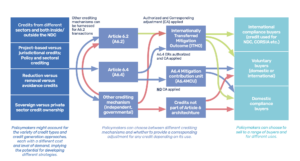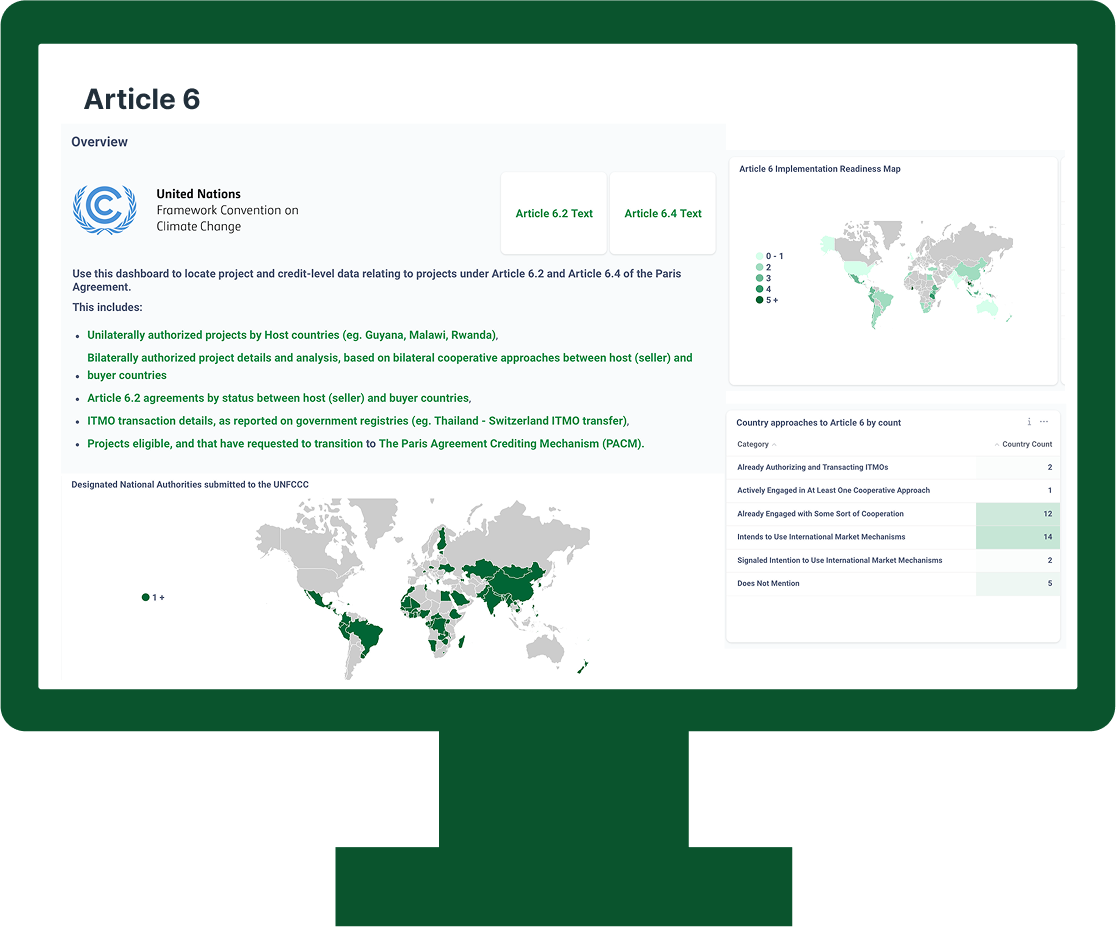
Voluntary Carbon Market Insights & FAQs
Everything you’ve ever wanted to know about the voluntary carbon market – and more!
Article 6
What is Article 6?
Article 6 of the Paris Agreement establishes mechanisms for international cooperation to achieve global climate targets. It provides a framework for countries to trade carbon credits, allowing them to meet their nationally determined contributions (NDCs) while promoting sustainable development.
There are three primary mechanisms under Article 6:
- Article 6.2: Bilateral/Multilateral Cooperation
- Article 6.4: The Paris Agreement Crediting Mechanism
- Article 6.8: Non-Market Approaches (NMAs)
What is Article 6.2?
Article 6.2 enables countries to trade carbon credits through bilateral or multilateral agreements. These credits, referred to as Internationally Transferred Mitigation Outcomes (ITMOs), are tracked and reported under a robust accounting framework to avoid double counting.
Article 6.2 offers flexibility and direct negotiation opportunities between countries, often leading to faster project approvals. It’s an avenue for businesses to engage in high-quality projects aligned with national climate policies and corporate sustainability goals.
What is Article 6.4?
Article 6.4 establishes a centralized market mechanism, overseen by the United Nations, to promote sustainable development and emissions reductions. It aims to replace the Clean Development Mechanism (CDM) from the Kyoto Protocol.
Projects under Article 6.4 are likely to benefit from high standards of transparency and robust methodologies. For commercial entities, it provides opportunities to participate in a regulated, globally recognized carbon market.
What is Article 6.8?
Article 6.8 of the Paris Agreement emphasizes non-market approaches (NMAs) to support climate action and sustainable development. It provides a framework for countries to collaborate through activities like technology sharing, capacity building, and policy coordination. These approaches aim to enhance mitigation, adaptation, and resilience, especially in areas where market mechanisms are less effective.
How does Article 6.2 differ from Article 6.4?
Unlike the bilateral nature of Article 6.2, Article 6.4 is a multilateral, standardized mechanism governed by a supervisory body under the UNFCCC. It ensures more stringent oversight and global consistency.
Supply/Demand dynamics among A6.2 mechanisms
Policymakers are assessing the complex landscape of international carbon credit transactions, to determine the source of credit generation approaches (supply), aligning them to demand centres and deciding whether to apply corresponding adjustments for any credits depending on use cases.

Which countries have begin formalizing Article 6 into domestic legislation?
Rwanda, Tanzania, Cambodia, Kenya, Zambia & Ghana
Article 6 Frameworks
National Article 6 framework laws are regulations that help countries implement Article 6 market mechanisms, governing carbon markets, ITMO transfers, and emissions reduction projects. They ensure transparency, prevent double counting, and align national actions with global climate goals, while promoting sustainable development and supporting local communities. These laws enable countries to meet their NDCs and participate in international climate cooperation.
What are Corresponding Adjustments?
A mechanism ensuring that emission reductions are only counted once by adjusting the greenhouse gas (GHG) inventory of the host country to reflect transferred Internationally Transferred Mitigation Outcomes (ITMOs).
- Example: If Country A transfers 5,000 ITMOs to Country B, it deducts 5,000 tons from its inventory.
What are Internationally Transferred Mitigation Outcomes (ITMOs)?
Emission reductions or removals transferred between countries under Article 6.2. They are measured in metric tons of CO₂-equivalent and facilitate international cooperation on climate goals.
- Example: Switzerland buys ITMOs from Malawi to meet its NDC targets.
What are Authorizations?
The formal process where a host country approves the transfer of ITMOs or activities under Article 6 mechanisms, aligning with its climate targets. Under the latest Article 6.2 rules, host parties can unilaterally authorise activities.
- Example: Chile authorizes the transfer of ITMOs from a wind energy project.
What are First Transfers?
The initial transfer of ITMOs from the host country to another entity, triggering the need for corresponding adjustments in GHG inventories.
The First Transfer refers to the initial transfer of Internationally Transferred Mitigation Outcomes (ITMOs) from the host country to another entity, such as a buyer country or private participant. This transfer triggers the requirement for corresponding adjustments in the host country’s GHG inventory to ensure that the emission reductions are not double-counted.
Example:
- Host Country: Kenya
- Activity: A renewable energy project generates 10,000 ITMOs.
- First Transfer: Kenya transfers these ITMOs to Switzerland for use in meeting its Nationally Determined Contributions (NDCs).
- Action Required: Kenya adjusts its GHG inventory downward by 10,000 tons of CO₂ to reflect the transfer.
